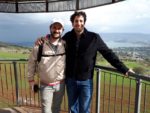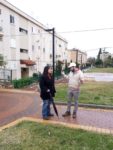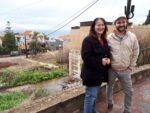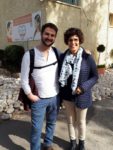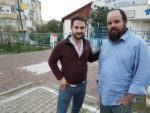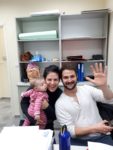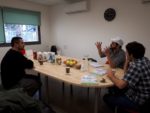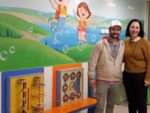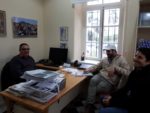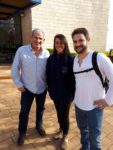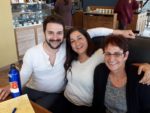Arrival in Sovev Kinneret
After an hour and two more buses, I arrived on the side of a busy two-lane highway on the North end of Kfar Tavor – hometown to our very own Shlicha, Tal Dror. Waiting for me was a warm smile with a person named Hadar. Hadar is the Living Bridge Coordinator for the Sovev Kinneret Partnership2Gether region. We had never met in person, but we eased into a new friendship switching back and forth between Hebrew and English. After a short drive, we arrived at the Lower Galilee Regional Council offices where I met Hadas Elad and her baby daughter. (There had been a fire at their regular offices at the Qaduri Youth Village, so they were crashing at this location while the mess was being cleaned up. I would later find out that luckily, due to the style of construction in Israel, the main structure had survived and just the interior needed to be renovated.) Hadas and I began to discuss the work she does and the challenges she faces. I was astonished at the similarities in the challenges between Kfar Tavor and its neighbors and our own local communities here in Saint Paul and across the river in MPLS. We both see our young people leave for bigger opportunities elsewhere, contend with varying opinions on polarizing issues, and the more general issues facing all people today.
Even more remarkable though were the differences in structure, attitude, and resources. Israel doesn’t fund social programs for local populations through donations. As a result of Israel’s socialist beginnings, all social programs are funded by the local and state governments. Don’t let that fool you – their official government-sanctioned hangout has beer on tap and a performance space. Israelis by nature are doers – usually trying something out figuring out what went wrong rather than over-planning beforehand. Furthermore, the people working in these roles were all truly passionate about every facet of their jobs and didn’t believe that their work ended when they left for the day. I would find that these themes repeated themselves time and again throughout my visit to Sovev Kinneret.
After we finished up, Hadar and I said our thank you’s and left for a tour of Qaduri Youth Village and Schools with Dafna Davidson – Pedagogical Director and Vice Principal of the school. Qaduri consists of an elementary school, a high-school, a boarding school, and a school for youngsters with Autism. What makes this school unique, beyond its on-site farm, the brilliant views, and beautiful campus, is the people. Qaduri is literally a microcosm of Israel’s diverse nature with youngsters from all backgrounds and walks of life including Jews (religious, secular, Ashkenazi and Mizrachi), Arabs, Circassians, Druze, new immigrants and at times even refugees – Muslim, Christians, and others. The make-up of the staff mirrors that of the children. I was impressed to find a high level of English present in the students’ work on complex topics including social justice, the sciences, music, agriculture, and more. These students weren’t just making their diverse study body function – they were thriving. It’s no wonder this school had produced such great people, like Yitzchak Rabin himself (and Tal Dror).
Thanking our guide, Hadar and I left for lunch where we’d meet up with Anat Sharvit and Idit Gross Mizrahi – Head of community engagement department at the Kfar Tavor JCC. Once again, an excited discussion flew around the table as we discussed the work of engagement and its dynamic nature. Idit and I spoke a common language (beyond just Hebrew and English) finding ourselves thinking many of the same big thoughts. We agreed to keep in touch and we were happy to have one another to call upon for advice and collaboration. Finishing the last sip of my blended mint lemonade, we hustled along on our busy day.
I’ve been to a lot of summer camps and volunteered with many that serve youngsters with special needs, but I’ve never seen an operation like the Jordan River Valley Village. This state of the art camping facility has literally everything a camp needs (and a bunch of stuff I’ve never even imagined) including a pool, gym, climbing wall and high ropes course, petting zoo, stable, playground, professional theater and auditorium, and I am just scratching the surface. Even more amazing though, is the level of medical facilities there as well. The camp runs three to five-day sessions throughout the year and has served almost 10,000 kids and their families with chronic diseases from Crohn’s disease to cystic fibrosis – and makes all of them feel like they can do anything. I’m not sure which was more inspiring and moving, the video telling the camp’s story or meeting its dedicated staff and volunteers – once again a veritable rainbow of backgrounds reflecting Israel’s diversity.
After the emotional high, Anat and I quickly fell into a adopted mother-son relationship. We shared our stories and backgrounds and quickly let our guards down. We traveled back through the hills to the Jewish Agency and P2G offices in Tiberias. I met with Dvir Alexander- Head of Student community program in Tiberias. This was a different story that I had heard before. I would soon learn that Tiberias is a complex city with a set of nuanced challenges that stemmed from Tiberias’ history. In the 1980’s, Tiberias had been a trendy vacation spot due to its temperate weather and its breathtaking views of the Kinneret (Sea of Galilee). Today, it is a city with little to no nightlife, no large commercial enterprises, and an increasingly siloed populace. Through my discussions with Dvir and his fellows (participants in Perach), I learned while there is a willingness to work hard, there is a sense of despondency at the current state of affairs. Folks are wary of optimism, but their resolve is not to be questioned. I was beginning to see the beauty and complexity resembled facets of our own reality back home in Minnesota.
After a long and exhausting day, I was glad to be in a quiet hotel room about halfway up the city. After a few moments of rest and reflection, I was pleased to see a handful of my new friends from Beit She’an who had come up to see me one last time before I’d be leaving Israel. After a relaxing meal of Israeli-style Chinese food overlooking the Kineret, they dropped me back at my hotel. Head still swirling with all I had learned that day, I finally fell asleep.
Day 2
But not for long. Another day in Israel, another night of too little sleep. It was raining as I waited for Ami, the taxi driver that Hadar had arranged the previous day. Ami was on-time (in Israel that means within 10 minutes of the agreed upon time) and he whisked me outside the city limits to the rolling hills nearby. We arrived to the Poriyya Hospital and I hoofed it from the main entrance to administrative offices about 500 meters up the hill. I glanced around and enjoyed the gentle drizzle refreshing the morning air. I found Hadar outside waiting for me and hurrying me along – this time it was me who was late.
I found Maya Tzaban in her carefully arranged office. After an offer of some coffee and the pleasantries, Maya offered me an umbrella for the rain. I smiled inwardly and declined – The rain she was describing would hardly be considered a drizzle back home. We toured around the hospital noting its constant state of under-construction. This was one of the most advanced hospitals in the country, making it amongst the most advanced in the world. Maya explained the various fields of medicine in which the hospital operated and we visited the various departments, ending in the children’s department with its brightly painted walls and gift closet – where kids can pick out a prize of their choice! Maya gave me a small parting gift, a small memento to remember the visit, which is now proudly displayed in my office.
Hadar and I next met up with Yael Pinian who led us on a driving tour of the history of immigration and absorption in Tiberias. This story, told through real estate development, helped me begin to understand how some folks in Tiberias were positioned to succeed more than others, an oversight based on something as simple as if one was given a small cottage or an apartment in a building. These issues became exacerbated when Israel went through a wave of privatization, making apartment buildings with many owners very difficult to renovate and update. We also drove through the newly developed Haredi neighborhood on the outskirts of Neighborhood D. With a new appreciation of the context of Tiberias’ development, Hadar and I unpacked the tour over a coffee and a croissant.
Ishai met us at the Alumot lookout which had views of the entire Sovev Kineret region, especially from the observation tower we scrambled up. Ishai was from a local kibbutz, Afikim, which he pointed out far below us. As we drove to meet up with Edna Lapidot for lunch, we discussed the local high school and how it offered a more flexible path to the completion exams (bagrut) all students eventually need to pass. At lunch, the discussion turned once again to the bigger issues – peoplehood and how it impacts our lives and work in the modern world. Ishai confirmed our next meeting and we drove over to the community center to meet Ehud Saly (the Head of Informal Education for the Jordan Valley) and hear about all of his successes in after-school youth programs. I was pleasantly surprised when he told me he was actually moving on to a new role working with young adults. We agreed on some rough plans to create some programming together – a dream of a joint trip to Poland and then to Israel, with folks from Saint Paul and from Sovev Kinneret. I was glad to meet another Jewish Doer in the network.
Finally, Hadar and I drove, Ishai in tow, to the Kinneret College for our final meeting. Yaki Ashkenazi (Head of the Israelis Studies Department at the Kinneret College) is an archaeologist through and through. Ishai had previously guess a few of the anecdotes that Yaki would mention over the course of the meeting – and he was right about every one of them. Clearly, Yaki was well-liked by his students. Our meeting ended in what was once a water tower, and was now a museum exhibit with an informal classroom, discussing ways to collaborate with local universities.
Good and truly exhausted, I was elated when Hadar told me she’d be able to drop me off in nearby Afula, effectively reducing the number of buses I’d need to take by three. We hugged one last goodbye, knowing that we’d get to work together and assuring one another that we’d be in touch soon. I slumped back into the bus seat thankful for all the amazing people I had met and inspired by what I had learned. I went on this adventure to get to know the place that is Saint Paul’s partner region, but instead, I had gotten to know our partners themselves. I’ve got high hopes for what we can achieve together.

